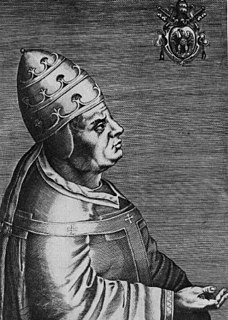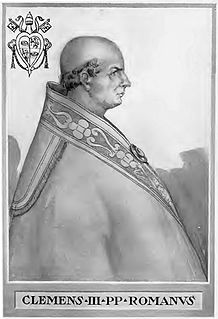
Pope Innocent II (r. 1130-43) created 76 cardinals in twelve consistories held throughout his pontificate. The pope created as cardinals his future successor Lucius III and the antipope Victor IV. [1]

Pope Innocent II (r. 1130-43) created 76 cardinals in twelve consistories held throughout his pontificate. The pope created as cardinals his future successor Lucius III and the antipope Victor IV. [1]

Pope Innocent II, born Gregorio Papareschi, was head of the Catholic Church and ruler of the Papal States from 14 February 1130 to his death in 1143. His election as pope was controversial and the first eight years of his reign were marked by a struggle for recognition against the supporters of Anacletus II. He reached an understanding with King Lothair III of Germany who supported him against Anacletus and whom he crowned as Holy Roman emperor. Innocent went on to preside over the Second Lateran council.
Pope Lucius III, born Ubaldo Allucingoli, reigned from 1 September 1181 to his death. His papacy was marked by conflicts with Holy Roman Emperor Frederick I, his exile from Rome and the initial preparations for the Third Crusade.

The Diocese of Sabina–Poggio Mirteto is a suburbicarian see of the Holy Roman Church and a diocese of the Catholic Church in Italy in the Roman province of the Pope.
Pseudocardinals or Quasi-cardinals were the uncanonical Cardinals created by six of the Antipopes, in or rival to Rome, including two of Avignon Papacy and one of Pisa, as princes of their schismatic Catholic church.

The 1159 papal election followed the death of Pope Adrian IV. It resulted in a double papal election. A majority of the cardinals elected Cardinal Rolando of Siena as Pope Alexander III, but a minority refused to recognize him and elected their own candidate Ottaviano de Monticelli, who took the name Victor IV, creating a schism that lasted until 1178.
Pope Eugene III (1145–1153) created sixteen cardinals in nine consistories:
Pope Lucius II (1144–1145) created eleven cardinals in two consistories.
Pope Celestine V created thirteen new cardinals in two consistories:

The 1118 papal election saw the election of Pope Gelasius II as the successor of Pope Paschal II who died January 21, 1118, in Rome after an over 18-year pontificate. Gelasius died after only one year in the papacy.
Pope Celestine III created eleven cardinals in six consistories. The exact dates for some of these consistories are not known.

Pope Urban VI created 42 cardinals in four consistories held throughout his pontificate. In 1381 he named his future successor Pope Boniface IX as a cardinal.

Pope Callixtus II created 35 cardinals in eight consistories held throughout his pontificate. This included one future successor and two future antipopes.

Pope Paschal II created 92 cardinals in fifteen consistories held throughout his pontificate. This included the future Antipope Anacletus II.

Pope Urban II created 71 cardinals in ten consistories that he held throughout his pontificate. He elevated his two successors Gelasius II and Innocent II as cardinals in 1088 and Honorius II in 1099.

Pope Honorius II created 27 cardinals in six consistories held throughout his pontificate. This included his successors Anastasius IV and Celestine II both in 1127.

Pope Adrian IV created 23 cardinals in three consistories held during his pontificate. This included his future successor Pope Gregory VIII in 1155.

Pope Alexander III created 68 cardinals in fifteen consistories he held throughout his pontificate. This included the elevation of his two future successors Urban III and Clement III and he also elevated a cardinal whom he later named as a saint.

Pope Clement III created 30 cardinals in three consistories held during his pontificate; this included the elevation of his future successor Pope Innocent III in 1190.

Pope Innocent III created 41 cardinals in ten consistories that he conducted throughout his pontificate. This included - in his first allocation in late 1198 - a future successor.